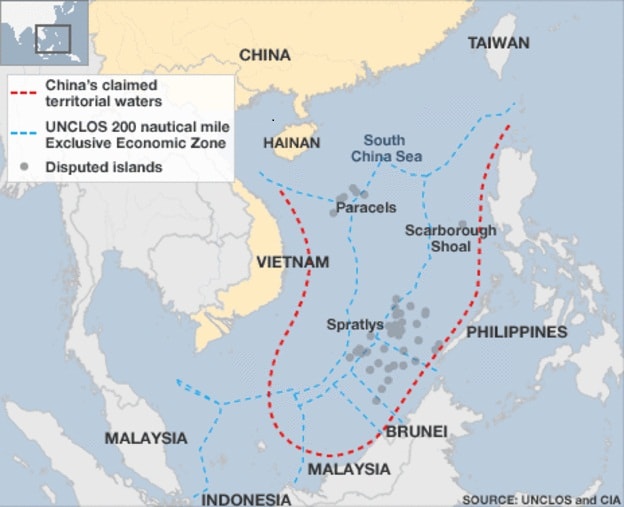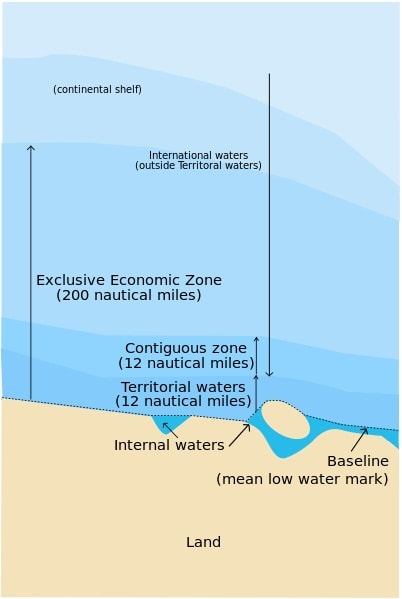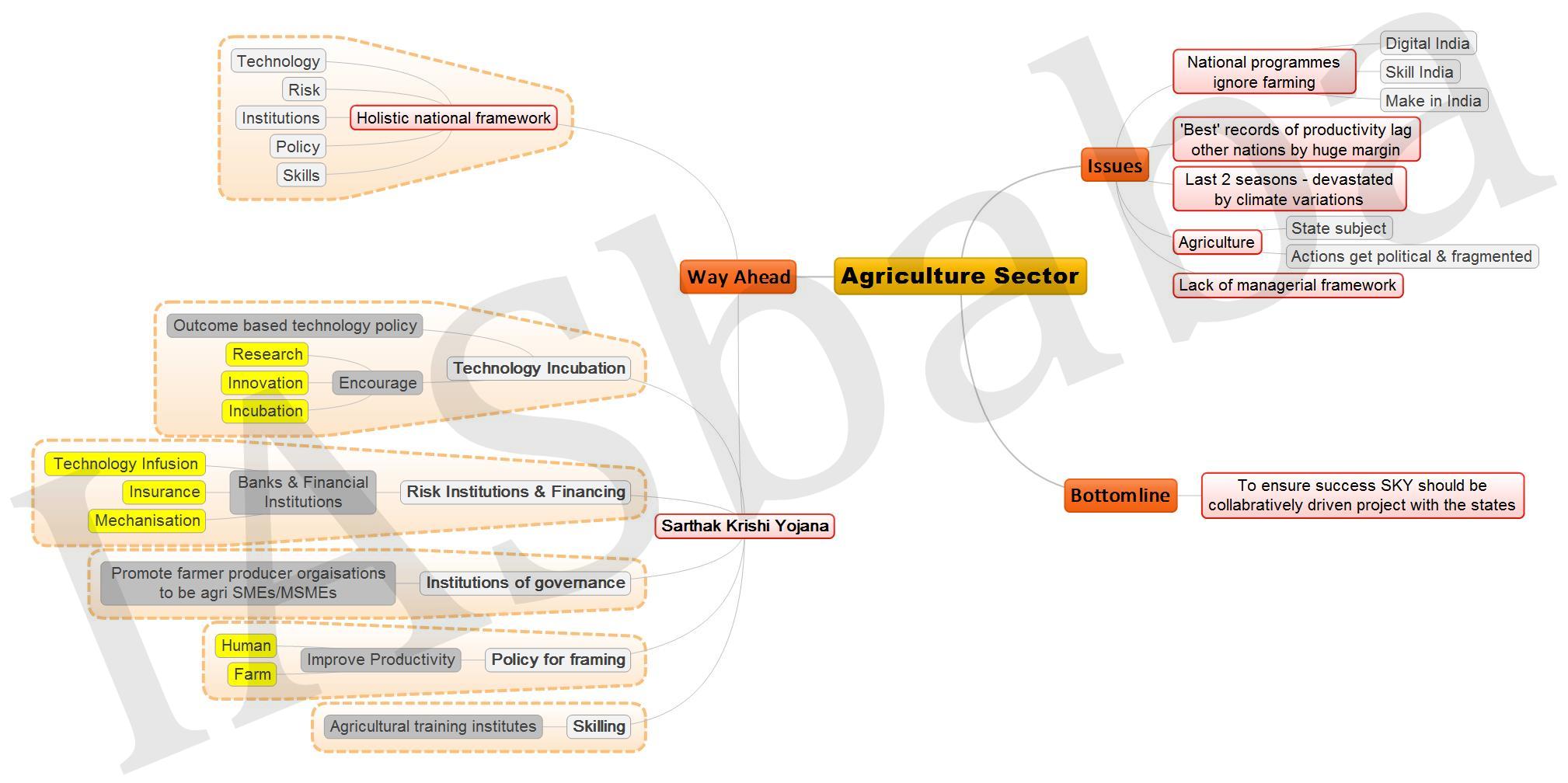IASbaba's Daily Current Affairs Analysis, IASbaba's Daily Current Affairs January 2016, International, National, UPSC
Archives
IASbaba’s Daily Current Affairs – 15th January, 2016
INTERNATIONAL
TOPIC:
- General studies 2:
- India and its neighborhood- relations.
- Bilateral, regional and global groupings and agreements involving India and/or affecting India’s interests.
- Effect of policies and politics of developed and developing countries on India’s interests, Indian diaspora.
- Important International institutions, agencies and fora- their structure, mandate.
Storm on the South China Sea
The Asia-Pacific region witnessed intense diplomatic upheavals over the South China Sea issue last year and it continues this year as well.
South China Sea Geography:

- Geographically, the South China Sea plays a significant role in the geopolitics of the Indo-Pacific.
- The South China Sea is bordered by China, Malaysia, Brunei, Singapore, Vietnam, the Philippines and Taiwan.
- Their significant economic growth over the last 20 years, as well as activity in other Asian economies including Japan and South Korea, has contributed to a large portion of the world’s commercial merchant shipping passing through these waters, from which it continues on through the Malacca, Sunda and Lombak Straits.
- The major island and reef formations in the South China Sea are the Spratly Islands, Paracel Islands, Pratas Islands, Natuna Islands and the Scarborough Reef.
Territorial disputes:
- The defining characteristic of the South China Sea and a significant source of tensions in the region are the competing legal claims of territorial sovereignty over its islands.
- Legal and territorial disputes persist, primarily over the Spratly and Paracel Islands as well as the Scarborough Shoal.
- Spratlys, have been reportedly occupied by claimants, which consist of Taiwan, Vietnam, the Philippines, China and Malaysia.
- The Paracel Islands are the subject of overlapping claims from China, Vietnam and Taiwan.
- Another major dispute is over the Scarborough Shoal, which is claimed by China, the Philippines and Taiwan.
China’s claim in the region:
- China makes the largest claim in the South China Sea, and bases it on the ‘nine-dash line’ map that was published by the Chinese Ministry of the Interior in 1947.
- The map served as the basis for the Declaration on China’s Territorial Sea, which was made by the Chinese Government in 1958 and laid territorial claim to a majority of the islands in the South China Sea.
- Additionally, in 2009 China submitted a diplomatic note to the United Nations Secretary-General, asserting its sovereignty over islands in the South China Sea which was presented with a map of the ‘nine-dash line’.
- The legality of the nine-dash line map, which China charges is based on historical evidence, is disputed by other South China Sea territorial claimants and under the UNCLOS Treaty.
A case of UNCLOS treaty:
- The United Nations Convention on the Law of the Sea (UNCLOS), is an international agreement which defines the rights and responsibilities of nations with respect to their use of the world’s oceans, establishing guidelines for businesses, the environment, and the management of marine natural resources.

If china claims rights over islands in South China Sea based on historic reasons, other countries claim rights as per UNCLOS.
- The disputed islands fall in the exclusive economic zone of the claimants.
Why does China want to control the South China Sea?
- Control of the South China Sea would allow China to dominate a major trade route through which most of its imported oil flows.
- It would also allow China to disrupt, or threaten to disrupt, trade shipments to all countries in East and Southeast Asia — as well as deny access to foreign military forces, particularly the United States.
- The floor of the South China Sea may contain massive oil and natural gas reserves. Sovereignty over the region could give China a level of energy security and independence far beyond what it currently possesses.
What is the issue now?
- Island building in the South China Sea, and construction on existing islands, has been going on for decades, primarily by Vietnam and the Philippines, which have claimed 21 and eight islands, respectively.
- Vietnam, Taiwan and the Philippines have all stationed military forces on at least some of their islands, but Vietnam, in accordance with UNCLOS regulation, has not put troops on what it calls “floating islands” — those constructed on submerged sandbars, reefs and other land masses.
- China has reportedly constructed more new island surface than all other nations have constructed throughout history.
- It might use some of these artificial islands for military purposes by building airstrips and long-range radar systems.
What is the U.S. response to the dispute?
- The United States had virtually no response to previous building by Southeast Asian countries in the South China Sea, but has vigorously opposed China’s efforts.
- The U.S. Navy has operated continuously in the region since World War Two.
- The United States has used its aircraft and naval vessels to assert freedom of navigation in the region.
- Beyond freedom of navigation missions, the United States is focused on strengthening regional allies.
- To do so, it has helped boost its allies’ intelligence gathering and surveillance capabilities, and provide them with updated military hardware to counter China’s technical advantages in both quantity and quality.
- Japan, in close coordination with the United States, is to supply military hardware to the Philippines and Vietnam.
Way ahead:
- Increasing presence of USA in South China Sea is escalating the dispute.
- International organisations should pressurise china for a dialogue on the issue and try to find peace in South China Sea.
Connecting the dots:
- Critically examine the impact of South China Sea dispute on India’s aspirations of being a regional super power in South Asia.
- Explain the South China Sea dispute and its impact on maintaining world peace and order.
NATIONAL
TOPIC:
- General studies 1: Role of women and women’s organization, women related issues, Social empowerment
- General studies 2: Mechanisms, laws, institutions and Bodies constituted for the protection and betterment of these vulnerable sections.
Gender Justice in Religious institutions: Case against Customary Exclusion
“Unless you [i.e. the governing board of the shrine] have a constitutional right to prohibit women entry, you cannot prevent them from worshipping at the shrine”
Shrine: Sabarimala shrine in Kerala
Case: Whether women can be barred entry to the Sabarimala shrine in Kerala
In Question: Relationship between freedom of religion, equality, individual rights, and the extent to which the court can interfere in the management of religious institutions
Let us examine them one by one:
Religious freedom clauses: Articles 25 and 26
- Article 25(1) guarantees to all persons the right to freely profess, practise, and propagate their religion
- Right to worship does not extend to worshipping in any and every place
- Access to places having a “particular significance for [a particular] religion” is constitutionally protected
- Enforceable against the state, and not against other individuals, or corporate bodies
- Article 26(b) grants to religious denominations the right to manage their own affairs in the matter of religion
- Entry of State: Article 25(2) allows state intervention in religious practice, if it is for the purpose of “social welfare or reform or the throwing open of Hindu religious institutions of a public character to all classes and sections of Hindus”
A scene in the Constituent Assembly—
B.R. Ambedkar– supported, among others, by Rajkumari Amrit Kaur: Expressed specific concerns about the plight of women under religious law— and endorsed giving wide, interventionist powers to the state on the ground of the deep and pervasive role that religion played in the lives of Indians
Supreme Court:
- Has attempted to restrict the scope of the religious protection clause to “essential practices of a religion”
- Holds the view that the state cannot use the reform clause to “reform a religion out of existence”, it has nonetheless held that aspects beyond essential practices have no protection from state intervention
Sabarimala governing board’s Argument—
Prohibition of women is justified by “custom” and cites Kerala Hindu Places of Public Worship (Authorisation of Entry) Rules, 1965, which permit prohibiting women from accessing places of worship where “custom” or “usage” requires it
And the Court replies—
Burden upon the board will not merely be to establish the existence of a custom, but also that the custom is “essential” to the practice of the religion
The State and the Shrine
- Since the right to freedom of religion under Article 25(1) is enforceable against the state, and not against other individuals, or corporate bodies the question that the court must answer therefore is whether the Travancore Devaswom Board, which controls access to the shrine, can be equated to the “state”
- Earlier, the Kerala High Court already appears to have held that it can and previously, the Supreme Court has held that corporate bodies that are “functionally, financially and administratively” under the control of the state can be equated to the state for the purposes of fundamental rights
Case against Travancore Devaswom Board
- It is an autonomous body and while its members are appointed by the State legislature, it derives its main income from the administration of the temple
- Therefore, it might be difficult to argue that the board is functionally or financially under the control of the state
- And if the board cannot be equated with the state, then the constitutional right under Article 25(1) is not enforceable against it
Probable Consequences
Failure of the Board: If it cannot show that prohibiting women from entry is an essential religious practice, then it can no longer claim absolute immunity under Article 26(b)
And if the Board wins:
- The women worshippers can argue that prohibiting them from access violates their constitutional right to freedom of religion and right to worship under Article 25(1)
- Can attempt to demonstrate that the Sabarimala shrine has special and unique religious significance and thus, their Article 25(1) right to worship would stand established
- Supreme Court: If one private party obstructs another private party from exercising her constitutional right, then it is the duty of the state to effectuate her right by restraining the former from continuing with its obstruction
- Therefore, the women worshippers may ask the court to direct the state to take all necessary steps to guarantee that they are allowed to access and worship at the Sabarimala shrine.
Re-course by the SC—
- Kerala Hindu Places of Worship Rules speaks about “customs” and “usages”
- The Supreme Court has held that while personal law is exempt from the application of the Constitution, mere ‘custom’ is not
- It might therefore simply strike down the offending rule on the ground that it discriminates on grounds of gender, and therefore violates the Constitution
Thus, there is a need for the courts to craft a solution that advances the constitutional guarantee of equality, non-discrimination and freedom of religion, while remaining cognisant of the fact that the Constitution also guarantees the right of religious sects and denominations to self-governance.
Connecting the Dots:
- Is there a need to limit the definition of religion? Substantiate your opinion
- Will the knock of gender justice on the doors of religious institutions and judicial landscape be heard and responded to? Discuss
Related Articles:
THE POWER OF PARITY: ADVANCING WOMEN’S EQUALITY IN INDIA
MUST READ
Tech tonic for the heart of India
Stagflation risk ahead
Return of terror in Indonesia
Indian engineers, scientists in U.S. nearing one million
Pakistan’s polio plan needs global support
Related Articles:
Is India actually free of polio?
Startup shakeup- None of the e-commerce startups in India has yet made money. And with no entry barriers, e-commerce has seen several stampedes.
Bankruptcy law: key to tackling the burgeoning NPA issue- Reforms in bankruptcy laws can play a crucial role in economic growth and financial stability
Related Articles:
Dealing with Failure: Bankruptcy Code
Focus offline to make it big online: World Bank report- The takeaway from World Bank’s World Development Report is that there is no short cut for developing countries if they want to reap digital dividends
The return of public investment- It’s time to reconsider economic wisdom that prioritizes private markets at the expense of the public sector
MIND MAPS
1. Defence Procurement Procedure
2. Agriculture Sector
















